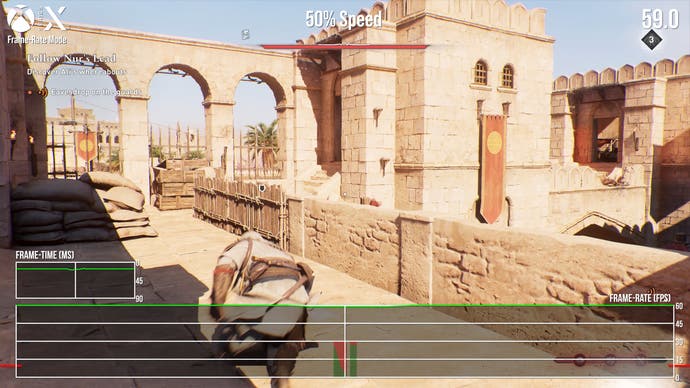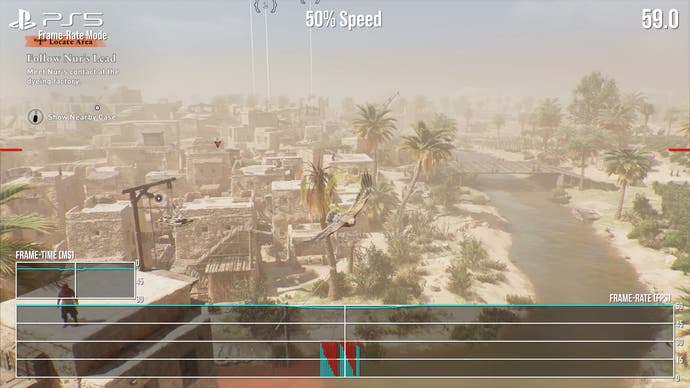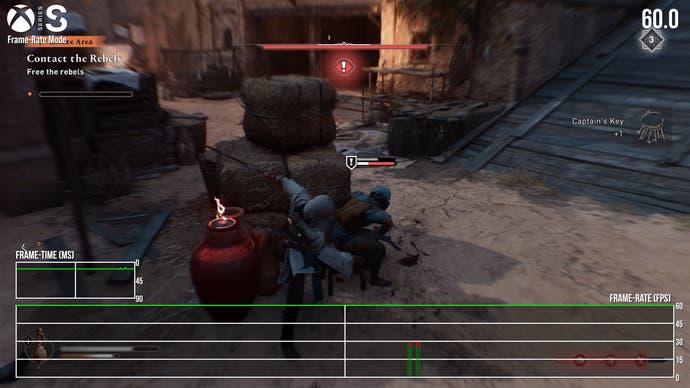Accomplished 30fps and 60fps modes for all hardware – including Series S.

Developed by Ubisoft Bordeaux, the Assassin’s Creed series celebrates its 15th anniversary this year with Assassin’s Creed Mirage. Originally meant as an expansion to 2020’s Assassin’s Creed Valhalla, the overall scale of Mirage is certainly dialled down this time around. Expect a shorter, narratively tighter adventure – which is no bad thing. Not every game has to be an epic. Mirage focuses on a single main character too this year, named Basim – a new recruit to the Assassin’s Brotherhood, who unleashes his parkour skills on a beautiful realisation of ninth century Baghdad. From the arid city outskirts to the bustle of the Damascus gates, all of this is brought to life by the Ubisoft Anvil Engine. But to what extent, if any, has the tech evolved from AC Valhalla?
Despite its connections to Valhalla’s tech, Mirage is a smaller project overall. Just looking at the install sizes on Series X says a lot: it’s a 33GB install – compared to 110GB for Valhalla right now. As scaled back as it is though, the Baghdad area of Mirage is still beautifully designed by Ubisoft’s artists. Every district of the city is crammed with detail: between the wells of the dyeing factory, right up to the stables ahead of the Prince’s Palace. The use of volumetric lighting is on point, too: at dusk, flare-ups of dust are caught by streaks of light, adding a strong sense of depth. The only blemish is that character detail doesn’t hold up: cloth physics only kick in at a certain range, while up-close, something doesn’t quite look right in the rendering of the human eye. The world design of Mirage is superb, but the character models filling it out still don’t quite hit the same standard.
Assassin’s Creed Mirage – the Digital Foundry video review.
This applies to every console from PS5 to Series X and X, which leads us to the comparisons. The first bit of good news is that all three consoles launch with the same options. There are two modes – as with Valhalla: a 60 frames per second frame-rate mode and a higher-resolution quality mode at 30fps. PS5, Series X and S are broadly identical in their quality modes. While targeting 30fps, the biggest dividing point is resolution. You get a dynamic 4K on PS5 and Series X, going down at occasional points to 1944p. On Series S we get a still-impressive dynamic 1620p, with a 1512p lower bounds.
In terms of visual differences otherwise, PS5 and Series X use precisely the same settings in textures, draw, shadow quality – and beyond. It’s only in comparing Series S to Series X that we see any real differences on the 30fps quality mode. Focusing on the two Xboxes, the margins are slight but worth pointing out. Firstly, during big panorama shots of the city, Series S reins in its level of detail setting for geometry, shadow and also tree quality. However, in the flow of play, the cutbacks are barely noticeable. In 60fps mode, Series S shadow quality drops still further, but it’s still a good looking release.
Generally, as you would expect, the 60fps mode trades resolution for frames. That means a drop to 1800p dynamic on PS5 and Series X, with 1440p as the lower bounds. As for Series S, it’s a dynamic 1080p in this case, with 864p as the lower bounds, a much more noticeable drop in image quality. Distant detail is less defined, but it’s a fair trade to get the game running at 60fps. Resolution isn’t the only element that gets pruned back to hit 60fps here. Taking Series X as an example, and comparing frame-rate versus quality modes, there are other tweaks. Notably, again, geometry and plant LODs are dropped. Otherwise though, both modes turn in a very similar experience on the streets. Texture quality, the volumetric fog, even the NPC count appears to stay in place regardless of mode.



In 60fps mode, all three current-gen consoles deliver very smooth gameplay, with just a touch of screen-tearing as dynamic resolution scaling kicks in when adjusting pixel-counts rapidly.
Switching over to performance testing, Mirage expectedly has a similar profile to series entries before it. There’s good news if you want to stick to the 30fps quality mode. Based on the first three to four hours of play, this is a watertight 30fps on every current-gen machine. The reading doesn’t even suffer a single frame blip during parkour action. The complex inner city areas stream in fluidly, whether it’s on horseback or flying overhead from an eagle-eye view. Simply put, Mirage stays at a flat 30fps regardless of what you do.
The situation at 60fps isn’t quite as polished. Effectively it is there 99 percent of the time, but there are ways to stress the engine to find that remaining one per cent. The gist is, making any rapid camera motion from the sky back down to the city incurs a sharp rise in GPU load. And within that moment the GPU load rises. screen tearing flares up at the top of the display, and at worst you’ll see a single frame drop. Likewise, for rapid camera pans from the outskirts to the city: it’s the game’s DRS system trying to play catch-up, by dropping the native resolution as quickly as possible once it recognises any GPU spike. Both PS5 and Series X have issues with this, though I’ve noticed tearing more frequently on Series X. Fortunately, the rule of thumb for the frame-rate mode is that it still holds well up on both. You get a fixed 60fps in almost every scenario, and really these moments are the outliers to the general experience.
Jumping over to Series S, again Ubisoft Bordeaux has optimised well for the 4TF profile of the system. The dynamic 1080p is nicely justified here: it runs at 60fps, with similar, occasional flashes of screen tearing to Series X. It’s hard to complain about the turnout though. It’s extremely playable at 60fps. The one major point to be aware of is that in-engine cut-scenes switch to a 30fps cap. Unlike PS5 and Series X – which just plough on through at 60 regardless – there is a forced half-refresh on the pint-size Xbox. However, as far as actual gameplay is concerned, nothing is lost. The Ubisoft Anvil engine has no issue scaling to Series S, and that bears out in the frame-rate even in complex city areas on horseback.
As a way to celebrate the Assassin’s Creed series’ legacy, Mirage doesn’t disappoint on the latest crop of consoles. Many of the issues with Valhalla – the early troubles with frame-rate stability in 2020 – appear to have been solved at launch this time. PS5, Series X and S owners all enjoy accomplished 30fps and 60fps modes from day one. Each hits the mark as you’d hope, too, where only the odd burst of tearing at 60fps holds each back from perfection.
Sticking to 60fps is my recommendation, especially given the sacrifices aren’t too dear for the premium consoles, with a drop to a dynamic 1800p, plus marginal LOD differences. As for Series S, the hit to a dynamic 1080p is obviously more pronounced in order to make 60fps work, but if you’re not happy with that, the 30fps quality mode is a worthy alternative.
So, going back to my first question: has the tech evolved that much compared to Assassin’s Creed Valhalla? The truth is, we’re looking at minor changes overall, but that’s OK when the end product is as solid as this. That said, we can’t help but feel that the series’ technology is still very much rooted in the cross-gen period – and we’d hope to see more ambition from Ubisoft in whatever comes next.
>>> Read full article>>>
Copyright for syndicated content belongs to the linked Source : EuroGamer – https://www.eurogamer.net/digitalfoundry-2023-assassins-creed-mirage-delivers-a-polished-experience-on-all-current-gen-consoles































